|
FAQs about the Diseases
of Clownfishes 23
Related FAQs: Clownfish Disease 1, Diseases of Clownfishes 2, Diseases of Clownfishes 3, Clownfish Disease 4, Clownfish Disease 5, Clownfish Disease 6, Clownfish Disease 7, Clownfish Disease 8, Clownfish Disease 9, Clownfish Disease 10, Clownfish Disease 11, Clownfish Disease 12, Clownfish Disease 13, Clownfish Disease 14, Clownfish Disease 15, Clownfish Disease 16, Clownfish Disease 17, Clownfish Disease 18, Clownfish Disease 19, Clownfish Disease 20, Clownfish Disease 21, Clownfish Disease 22,
Clownfish Disease 24,
Clownfish Disease 25,
Clownfish Disease 26,
Clownfish Disease 27,
& FAQs on
Clownfish Disease By: Environmental
Stress, Nutrition, Social/Behavioral/Territoriality, Trauma/Mechanical Injury, & Pathogens:
Lymphocystis, Infectious Disease (Bacteria, Fungi...),
Protozoans: Cryptocaryon/Ich,
Amyloodinium/Velvet, Brooklynella (see article below), &
Mysteries/Anomalous Losses, Cure, Success Stories, & Clownfishes in General, Clownfish Identification, Clownfish Selection, Clownfish Compatibility, Clownfish Behavior, Clownfish Systems, Clownfish Feeding, Clownfishes and Anemones,
Breeding
Clowns,
Related Articles: Clownfish Disease, Clownfishes, Maroon
Clowns, Marine Disease, Brooklynellosis,
|
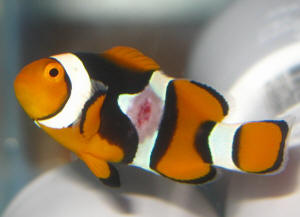
|
|
sunken head on clown fish! 8/9/10
Hello,
<Hi there>
I am seeking assistance on a sick clown fish I have. I have been
one the forums but no one there is quite sure. I believe he is an
Amphiprion melanopus though he was marked under the common
heading of tomato clown.
<I do agree with both nomena>
I have had him for over two years now. He is very active and
bright but he is very thin. He has never put on weight like any
of his tank mates. After feeding time my solar wrasse could pass
as a mom to be . He has always been thin but seem to very slowly
getting worse. At the moment he seems emaciated with a sunken
area above the head. He also just tapers into his tail like a
wedge and has no real belly. He has grown but very slowly and not
to the size I would expect living in a 120. I have attached some
pics; they are not very good I don't have a camera that works
for aquariums real well. The first is a pic of the clown as a
baby when I first got him several years ago and the other are
pics of him today. He is fed a varied diet that includes frozen
Mysis and brine shrimp, krill, a formula for omnivores and he
gets some of the frozen angel and butterfly mix. They are also
given formula one and two pellets and dried seaweed. They are
usually given one cube of frozen food in the morning and
supplemented with pellets in the evening. He eats a good amount
of the food; he is not too shy to get in there with the other
fish to get his share. As far as living conditions he is in a 120
FO system. It currently has two refugium systems (a 30 gal and 5
gal), a sump (5 gal w/ live rock) and a protein skimmer for
filtration. The tank contains : 2 green banded gobies, 1
Valentini puffer, 1 yellow Coris wrasse, 1 solar fairy wrasse, 1
six line wrasse, 1 purple Firefish, 1 tomato clown, 1 Sailfin
tang, 1 Pearlscale butterfly, and 1 starry blenny. As far as
water parameters the salinity is kept between 1.021-1.022,
<I'd raise this a few thousandths>
the ammonia and nitrite are zero, and the nitrate was at 50 two
days ago.
<Way too high; likely a factor here>
I am working on lowering it!
<... see WWM re>
The clownfish was losing weight long before the nitrate level
rose. I was wondering if he could have been living with an
internal parasite for all these years.
<Yes; a possibility>
If so why do none of the other fish show symptoms?
<Perhaps species specificity; maybe no intermediate host/s for
the parasite here>
Is it also possible that he could have some metabolic disorder
that is the cause of this slow decline?
<Yes also... genetic vs. ontogenetic/developmental>
Whatever is the case how do I fix things?
<Perhaps improving the nutrition will rectify at least the
looks of this fish. I do encourage you to add Spectrum pelleted
food; make it the staple for all your fishes here. A bit of
background: http://wetwebmedia.com/SpectrumFoodsF.htm>
Thank-you for your time, Jen
<Welcome. Bob Fenner>
|
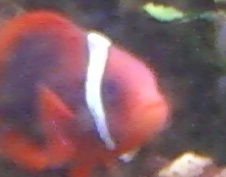 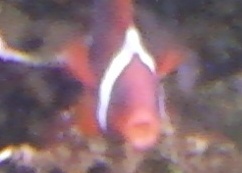 |
|
Re: sunken head on clown fish!
8/11/10
Thank-you for the information. I do use spectrum foods for my
freshwater fish and with my larger saltwater fish. I will look
into getting a smaller pellet for these guys as well.
<Ah good>
I was just wondering would it be wise to use their anti-parasite
food or would this cause undesired effects on the environment
(live rock, inverts, etc. .)?
<Not really. It just includes garlic/Allium>
Also once all the water parameters are improved and if this
increased diet doesn't seem to help him is there anyway to
determine if it is a parasite or just a condition he suffers
from?
<Not easily, no. Requires either sacrificing (killing) the
animal and microscopic examination or involved sampling
otherwise>
I would hate to just have to put him through a bunch of different
treatments all for nothing.
Jen
<I would not treat this animal. BobF>
|
|
Clownfish questions with 2 attached photos
8/4/10
Hi,
<Howsit?>
I am so glad that you all are available for help. I've
scoured the clownfish info regarding disease and habits on the
wetwebmedia.com site but still have some questions. Here
goes...
Background:
I started my first marine aquarium in early April of this year
(2010). It is fish only with live rock. My first addition was a
clownfish who is in the attached photos and is the primary focus
of my questions. From the start I noticed that he had thin
whitish feces. I thought that something could be askew so I asked
about it at a local fish store and was told that it's
normal.
<Can be; though might also be indicative of biological lumenal
issue/s>
I couldn't seem to wrangle if by normal he meant that it was
normal due to stress or was a normal trait of the species. I kept
an eye on the situation and noticed that the clown's feces
consistency and color changed a bit according to diet but trended
longish and lightish. I primarily feed Hikari Marine S pellets
and roughly two times a week I'll treat him and the rest of
the crew with Hikari frozen brine shrimp.
<I'd expand this diet>
The rest of the crew consists of; two Firefish and a yellow
watchman goby.
Each individual was added to the aquarium at roughly 2-3 week
intervals. I made the newbie mistake of not using a quarantine
tank and my fish paid the price. At this point nothing fatal but
I'm working to rectify and to do the best by them. What
happened was that one of the Firefish showed signs of marine ich.
I went to a local fish store and was told to put Quick Cure in my
display tank.
<Yeeikes!>
Thank goodness I didn't. I went to the next closest store and
they gave me Kick-Ich.
<... worthless>
That simply didn't work for me. I did more investigation and
read about the lifecycle of the Cryptocaryon irritans and decided
to pull everyone out of the display tank to let it lay fallow for
6 weeks while I began treatment of the fish.
<Ah, good>
After setting up a 20 gallon hospital tank I found another local
fish store and asked about treating ich. I was given Seachem
Paraguard and was told to treat all of the fish for 21 days. I am
currently on day 16 of treatment and it looks like it's so
far, so good. After two days all visible signs of ich were gone
from the Firefish and it has not returned. With that apparently
cleared up my attention has returned to my clownfish. With the
fish in a bare bottom aquarium I'm better able to watch for
symptoms. Chalk this up to lessons learned.
Specific clownfish questions:
His feces still appear to be whitish and thin. Infection or
parasite?
<Perhaps neither... You might/could treat (through foods) with
antimicrobial/s, antiprotozoal (Metronidazole). Detailed on
WWM>
I do not know if this is meaningful, but, by eye I can tell that
he has grown a good bit. When I first got him I had to break all
but the smallest pellets in order for him to be able to eat
them.
<Look to the Spectrum brand... they make very small
pellets>
He has grown past the threshold where pellet size is no longer an
issue.
He's a voracious eater when it comes to the pellets and goes
nuts for frozen brine shrimp.
<Ah, a good sign>
As far as the other fish go their feces appear to be normal. The
clownfish was separated from the rest of the group when he
adopted and began defending all PVC pipes in the aquarium. This
has made identifying whose poop is whose when vacuuming for water
changes. I vacillate between thinking that I'm overreacting
and thinking that I should do something. At this point I'm
simply confused. IN a fit of "do something" I picked up
Seachem Metronidazole but do not want to medicate if it is
unnecessary.
<Use only once if you do>
Coupled with the information above and the attached photos below
what course of action do you recommend?
<Nothing... as in to "do", treat w/ nothing other
than the Paraguard you're finishing up with>
I have one more question. When he rests at night his color fades
and he becomes quite pale. Is this normal?
<Yes>
While he was in the display tank I could not/did not observe him
closely when the lights were off. In the hospital tank, most of
the time, he turns on his side and slowly works his way back and
forth across the available width. And sometimes he sits high in
the front right corner. From what I've gleaned from the FAQ
info this set of behaviors is normal. *fingers crossed*
<Is>
I dose the tank with Paraguard at 10:00 p.m. I figured that by
adding the medication to the water its oxygen level is lowered
somewhat so I added an airstone (submerged my old Oceanic protein
skimmer without the cup, obviously) to boost O2. Other surface
agitation/filtration is provided by an AquaClear 20 hang-on power
filter. By morning when the clownfish is up and about his color
comes back and he looks pretty good. I took the attached pictures
just moments before writing this email.
Should I shift the Paraguard treatment away from the fish's
dark resting period? Is there something else that I should
do?
<I would stick with your current protocol>
I thank you very much for your time,
Nathan
Basic water parameters:
Ammonia: 0
Nitrite: 0
Nitrate: <5
<And you for sharing Nate. Bob Fenner>
|
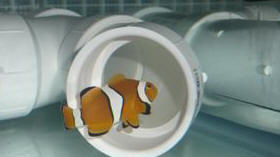 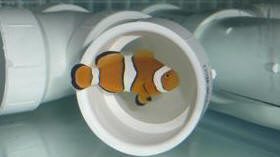 |
|
Clownfish... fwd msg... reading re dis. --
7/4/10
Good day-
Attached is a blurry picture of a new clown with what appears to
be an intestinal parasite or infection, I'm sure not clear
enough to make a firm diagnosis...but clear enough to get
close.
I just received him yesterday and part way through his
acclimation, started to show signs of stress. I elected not to
put him through my typical Formalin bath (because of his stressed
condition) and quickly dipped him
for about 5 seconds and rinsed in freshwater for 5 seconds (all
temp. & PH adjusted), then into the QT .
I thought I would loose <or lose> him overnight as he
continued to worsen, laying on his side and sometimes upside
down.
This morning I surprised to still have him although he was still
lying on the bottom sideways....when suddenly he started to pass
the whitish stringy fecal matter, with small knots every so
often. I would guess internal parasite or such....
I have a tough decision here....
I think typically the parasite would not kill the fish as quickly
as the stress, with that in mind...I would be inclined to wait to
see if he recovers before administering another form of
treatment.
Should I start a Prazi treatment right away in his stressed
condition or wait a day or so?
<I'd wait>
Could the Formalin rinse have killed the parasite and he is just
now expelling it, and perhaps recover with no further
treatment?
<Not if it is/was internal, no>
His tank mates came with him, another clown and a juvenile Dory
both of which made it through the full 15 minute Formalin bath
and subsequent rinse fine...they would get the treatment also, as
I have only the one QT...?
Your advise would be greatly appreciated.
Best regards,
Ron
<... read here: http://wetwebmedia.com/clnfshdisart.htm
and the linked files above. Bob Fenner>
|
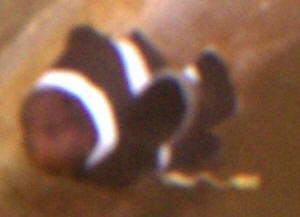 |
|
Re: Clownfish... fwd msg... reading re
dis. 7/4/10
Sir-
<Ron>
Believe it or not he still lives..but no improvement (a tough
guy). The other clown appears to be blind. Shows no similar
behavior to the first, but continually bumps into things,
including the Dory.
Not much I can do here, unless you have any suggestions, but go
with the flow as we say.
Thank you...
<Read where you were referred to. B>
|
Clown Fish Help, Disease
6/12/10
Hi,
<Hello>
I have read your site a lot when I started to get into saltwater, so I
figured it would be a good idea to ask for help when I need it too. I
have a 55 gallon tank that's almost 2 years old, it has 2 Damsel
Fish, 1 Clown Fish (Ocellaris), 1 Scooter Blenny
<Will likely need a larger tank to get enough food.>
and 1 Coral Banded Shrimp. The Damsels have been in the tank for almost
1 1/2 years, Clown Fish for almost an entire year, Scooter for 6
months, and the Coral Banded Shrimp for 8ish months. Everything had
been going fine,
but lately my Clown Fish has started to get little white dots (Smaller
then a grain of sand) forming all over the top of his body, his skin
has also darkened in that area. His breathing seems a little labored
and he hangs out near the bottom of the tank not really moving much. He
is still an active eater and comes up for food (Frozen Shrimp mostly
and brine shrimp that I give the Scooter, when he can get it).
<Brine shrimp are potato chips, nutritionally worthless.>
I'm sure something is wrong but I'm not really sure what. The
guy at my pet store said it might be Ick, but I though that only got
fish that were under stress, and I'm quite sure he is not.
<Ick is caused by the parasite Cryptocaryon irritans, stress has
nothing to do with it.>
Tanks readings are at Specific gravity 1.025
Ammonia 0
Nitrite 0
Nitrate 0
PH 8.2
All these are what it has been for weeks with little to no change.
I have a Fluval FX5, and a hang on filter, so I'm sure its likely
not a water quality thing.
There is also about 40-50 pounds of live rock and a 2 1/2 inch base of
sand on the bottom of the tank.
Any advice to help my clown fish would be much appreciated.
<See here http://www.wetwebmedia.com/ichartmar.htm,
and here
http://www.wetwebmedia.com/clnfshdisart.htm
.>
<Chris>
|
Clownfish Sores 6/7/10
Good Evening,
<Good morrow to you Adam>
Where to start... I moved a pair of clownfish that I had, had in
my possession for several years into a new 120G tank (with 60G
fuge in the basement, and 40G sump in the basement), after proper
cycling etc. Shortly after moving them in, they started to get
these white sores on the sides of their bodies / fins, which
would eventually slough off exposing the muscle underneath. They
would then heal, and the clowns would get new sores, rinse and
repeat. None of the other fishes were effected.
<Mmm>
A purple tang I also had in my possession started to show signs
of ich, so I took all the fish out of the 120DT and treated them
all with hypo. This was the first time I had tried hypo and
unfortunately I killed all of my fish save a couple which I gave
away because, as far as I can tell, the pH dropped rapidly (less
buffering capacity in hyposaline conditions), hard lesson to
learn.
<Yes... much more than "salts" lost utilizing this
technique
(hyposalinity); carbonate, bicarbonate among others>
Fast forward 3 weeks later, I bought two new clownfish and a
mandarin.
Since I did not have any fish in the tank I did not QT, as I can
get the clowns out if need be. If you are wondering about the
mandarin, the tank is now close to 3/4 of a year old, and there
are plenty of pods for him, he is significantly plumper now than
when I purchased him, and there are still plenty of pods for him
to eat.
Now to the problem. The new clowns I purchased started to show
signs of this ulceration that my old clowns suffered from. There
is no change in their behavior, no change in appetite, no change
in breathing, no signs of disease except they get these nasty
sores. I would have taken them out a while ago and treated them
in QT, however, my research has no been able to come up with what
exactly I am treating. Whatever it is, is not fatal. The sores
seem self limiting, however like I mentioned before, once one
heals usually another starts. Initially there appears to be a
cottony growth, which loosens, and then falls off. If the sore is
on the body, the muscle is exposed, and if it is on a fin, the
whole part of the fin ends up missing.
Does not look like ich, velvet, or brook.
<Agreed>
More details about my tank. It is a 5 foot 120, lit with 3 MH,
two Vortechs, apex controller, dose bulk reef supply 2 part with
Mag, have a Deltec and octo skimmer, all of my parameters are
those to be expected of a successful reef tank. Undetectable
ammonia, nitrite, nitrate and phosphate.
450 Calcium, 9 Alk, temp is 77, salinity is 1.025. Corals are
doing great.
Mandarin is also apparently disease free.
<All good data>
Picture CF1 shows the female with an early sore on her tail. Then
CF2 shows
its progression. CF3 shows the female with an end stage lesion
where it is no longer getting any bigger. CF3 also shows the male
with a lesion at the base of his tail, and then another starting
on his tail.
OCF1 is a picture of one of my old clown fish that had a sore on
his body.
Same type of sores that these are getting.
Thank you for your time,
Adam
<These marks look to be sores... from burns/stings, likely
from the Euphylliids in your photos, kept in the same system.
Either your Clowns will "make peace" with the
Euphyllia, Catalaphyllia present, or perish from them. Mmm, do
read here: http://wetwebmedia.com/clnfshanmf7.htm
and as much of the linked files in the series (above)... Bob
Fenner>
|
 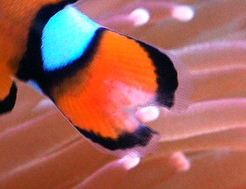 
 |
|
Re: Clownfish Sores 6/7/10
Hi Bob,
<Yo Adam>
Your theory seems quite sound, when my old clowns moved from the
old 60G, to the new 120, they were hosted by a torch as opposed
to the frogspawn that had previously hosted them (torch has a
much stronger/stickier sting).
<Agreed>
The new clowns are hosted by a rather large and mean elegance
(the elegance regularly eats my snails).
<I saw this in your excellent photos>
I do have a bubble tip anemone, however it lives on the other
side of the tank, I do not see the clowns finding it on their
own.
<Perhaps in time>
There is an easy way to test this. I will put the two clowns in
my fuge/frag tank in the basement, which shares the same water
from my display.
The only difference being there is a complete absence of
Euphyllids.
<Ahhh!>
I will get back to you and report if there is any change.
<I thank you>
Thank you for your time. As usually you have been incredibly
helpful.
Adam
<Welcome my friend. BobF>
Re: Clownfish Sores 6/13/10
Well done Bob!
<Medium rare please!>
Already less a week in the fuge and my clown fish are healing
well. No new signs of sores, and all the damage done is repairing
itself.
<Ah good>
Would it be worth while to try the clowns in the elegance for a
while longer? Or shall I just bite the bullet and sell the
elegance?
<It looks like a very nice specimen... How about moving it
(the Catalaphyllia) to your refugium? This species can "get
by" just fine w/ not much light (along with regular
foods/feeding)... or another system entirely?>
Thanks again,
Adam
<Congratulations on your success. BobF>
|
Skunk Clown Has Problems
6/5/10
Hi,
We've had our pink Skunk Clown for several months now. He's
been hosting in a Condylactis anemone
<Mmm, can "work out", but not always... Not native
partners as you know>
and has always been active and "normal". About 2 weeks ago,
he stopped hosting (the first thing we find strange) and now
floats/swims at the top of the tank on his side (weird but normal
swimming behaviours for clowns, I
know). As of yesterday he has developed a bubble on only one of his
eyes and it appears to be red in the center. Any thoughts? advice?
Thanks!
Amy
<Some sort of injury likely... physical most probably... Only time
(not moving, medications) will improve. Perhaps read here:
http://wetwebmedia.com/clndistrauma.htm
Bob Fenner>
Not sure if this is Brooklynella
5/24/10
Hi Crew...
<Gretchen>
I've had my ocellaris for a year (introduced into the tank with
another one, but that one died 6 months later). It's no The
ocellaris was previously in a 45g fowlr, under t8 bulbs. Moved him to a
125g in February, which did not have lights for 3 months. I now have
temporary lights on it (a 2 bulb 30" t5--SunPaq). That's when
I noticed his color not as bright (due to lack of lights?).
<More likely nutrition>
No behavior problems outside of silly clown behavior. I got another
ocellaris 2 weeks ago (I don't think it was tank bred hence my
worry of brook). The color difference is noticeable -- the new one is
much vibrant than the first one. They have not had violent struggles,
and in fact, they seem to be sorting themselves out peacefully.
I came back from a 4 day vacation (I had a sitter handle feeding them
pre-measured food).
<Smart>
I noticed the first clown is looking very slightly ashy. But he's
eating (he is not spitting out the food he's taking in), not
hiding, not being shy, not swimming funny or rubbing on things, no
heavy breathing or hanging around the surface gasping for air. I also
remember last week seeing white stringy thing out of his bottom (which
your site indicates it's a sign of a parasite). Haven't seen it
since, though.
It's been 7 days since seeing the white stuff, and my clown is
behaving as clowns do.
If this is brook, would it have killed him by now?
<Likely so>
And if it was the other clown who introduced it, would it have taken 2
weeks to manifest itself in the 1st clown?
<Not likely at all>
The newer clown has no signs of illness whatsoever; on the contrary, it
seems very healthy and vibrant. If it had introduced brook, would it
have died by now?
<... yes>
Or can it just be a carrier?
<Not really... weaker individuals may "show" symptoms
sooner, worse... but all Amphiprionines will become infested in
time>
It's just the first clown that seems a bit off. He was doing this
thing with he diamond goby though, that seemed odd, even for a
clownfish....
http://www.youtube.com/watch?v=T6nYkmEvJAM (feel free to remove that
link if I'm not supposed to post videos; but it shows the odd
behavior). He did this many many times over 3 days. I haven't seen
him do this since I got back though. Don't know what to make of the
whole picture.
Other fish (3 Chromis, 1 Banggai, 1 Firefish, 1 diamond goby) appear to
be healthy. A month ago I had a sick Tang with a parasite (probably
Paravortex, but never found out) that I removed from the dt, but he
died in QT. No signs of similar symptoms on anyone (tang had black
spots).
Parameters: ammonia and nitrites 0ppm, nitrates: 10-20ppm. Chaeto in
the sump, lots of flow. Should I risk qt'ing the clown if he
otherwise seems healthy?
Thanks
Gretchen
<Read here: http://wetwebmedia.com/brooksympf.htm
and the linked files above. Bob Fenner>
Clownfish, NH3... reading
5/13/10
Dear Crew,
After the recent death of my purple Firefish, I have noticed that my
small clownfish (2" tops) has what appears to be Finrot (or it
could be an abrasion, as he shelters in LR) and has a faded white
blotch around his dorsal fin. Any ideas?
<Re?>
If the description is not accurate enough I could provide a picture
soon.
Tank parameters are all zero excluding ammonia (.05 ppm, if that).
<Deadly toxic...>
I have yet to purchase any non basic test kits, (phosphorous, calcium,
magnesium etc.) so I am not yet certain if one of those is off.
Warmest regards,
Sam Sutton
<See WWM re Clownfish, http://wetwebmedia.com/marine/fishes/FishInd2.htm
toward the bottom of the page... and Ammonia... Don't write w/o
searching, reading first. BobF>
Re Clownfish, NH3... reading
Ach, my apologies, I meant .005 ppm. Quite the difference, hehe. I will
review the provided link, however.
<Real good. B>
|
Facial tumor? Clownfish dis.
4/20/10
I apologize for not being more read in the subject of fish
pathologies; however, my 3 year old clown has developed a fairly
rapidly growing growth on his cheek over the past week. It
currently is approximately 6mm x 4mm x 3mm. It is not discolored.
He is able to eat and has not lost his appetite. It appears hard,
but I have to admit I have not felt it. I am hoping that you may
point me in the right direction, as far as the most likely
causes, that I may research them further. Thank you
75g mixed reef w/ 40g refugium
Water parameters within normal limits
1 other clown x2 years
Anthias x4 months
Note: Purchased two other Anthias with the remaining Anthias,
both ate well but perished (disappeared) within 2 weeks of
purchase. (No surfing to my knowledge.)
<Mmm... Could/would you send along a well-resolved photo of
this growth?
Most such processes can be traced to a mal-interaction with a
Cnidarian "host"... Please read here: http://wetwebmedia.com/clnfshanmf7.htm
Bob Fenner>
Re: Facial tumor? 4/21/10
Here are some pictures, let me know what you think. Thanks for
your help
<Is as I suspected... welts, from stings. Read where you were
referred. B>
|
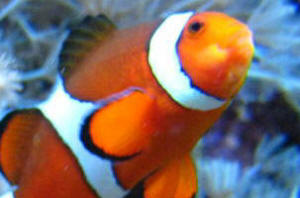 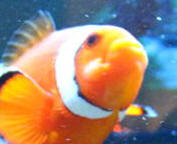 |
Sluggish Clownfish -- 4/12/10
Hi,
<Hello>
I am just starting off in marine and your website has proven
indispensable in setting up my tank.
I know I am overly anxious so apologies if I'm panicking too
quickly but I just don't want to lose my fish so early on.
I recently bought two clownfish, I had the waters tested before I
bought them and all the parameters are good.
In the tank I already have 1 skunk shrimp, 1 brittle starfish, 3 snails
and a small bit of coral.
The 2 clownfish started off well but today I notice the bigger of the
two is acting sluggish.
<Not atypical behavior>
There are no signs of disease that I can see but she seems to have lost
interest in food and is not moving the same way as she was.
Everyone else in the tank seems to be fine, any thoughts or advice
would be greatly appreciated?
Thanks for your help,
Keelin.
<What re the system make-up, foods/feeding...? I would not be overly
concerned if the other specimen is otherwise "acting fine"...
Do keep reading on WWM re Clowns... and offering a variety of foods.
Bob Fenner>
Re: Sluggish Clownfish 4/13/10
Hi,
<Howsit?>
Thanks for getting back to me, the system is made up of a bed of live
sand, tank is 1/4 full of live rock, 1 small piece of mushroom coral
which came with what looks like 3 transparent tic-type things buried in
to it.
Our alkalinity is a tiny bit high but otherwise all parameters are
good.
I'm hoping it is a personality thing, as our clownfish has been
feeding well since I wrote last but is still acting peculiar.
<They are "clowns"...>
She has been staring at the sand in chosen areas i.e. tail straight up
in the air and nose to the sand!
She is moving slower than she was but is still moving around the
tank.
Our other specimen is acting fine.....apart from tormenting our poor
old brittle fish, he had peace for a while
and doesn't know what's hit him now.
Thanks again,
Keelin.
<Read here: http://wetwebmedia.com/clnbehfaqs.htm
and the linked files above. BobF>
|
clownfish with welts -- 03/23/10
Good morning.
<G'morrow to you>
I was wondering if it is common for a clownfish to get welts on
it's fins when it first starts to host an anemone or
coral.
<Yes it is>
I know it isn't Cryptocaryon irritans because I have dealt
with that in the past and unlike a sprinkling of pin sized or pin
head sized dots these are more like welts/pimples on the caudal
and pectoral fins and one close to the dorsal.
<Agreed>
I saw these before on another pair of clownfish but only one or
two spots (but in the same areas) that to my knowledge never
hosted my BTA, but who knows what happens when the lights are
out. Since moving those clowns to my frag tank the welts cleared
up. My newer clowns spend all day in the anemone for the most
part but have only been together with the anemone since Saturday
( after 5 weeks of QT with no incident). None of the other fish
(a gramma and a YW goby) have ever had these marks. No excessive
slime, no torn fins, no heavy breathing or other signs of illness
like flashing either. They have voracious appetites as well ( and
even feed the anemone!) I have attached a few pictures. The
pictures of the spot by the dorsal shows its
"pimpleness" more but the spots on her tail are the
same, as well as the few on her pectoral, but harder to get a
clear picture of. Any help would be greatly appreciated.
Keith
<I do think this is likely "getting to know you"
reaction markings... though your last image, showing the
Zoanthids "next door", may indicate a mal-interaction
as well. Bob Fenner>
|
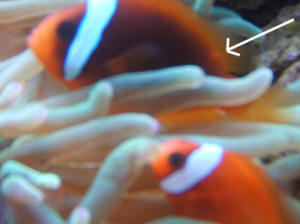 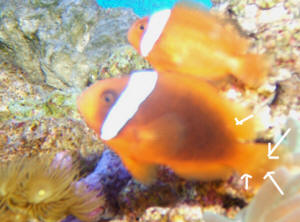 |
Clownfish with welts -- 03/23/10
I forgot to mention from my previous email with the same subject
line, I have seen the same clownfish with the more prominent
welts/ pimples willingly enter my torch coral and give a
"ouch I got stung" reaction...but yet still
occasionally does it anyway when not in the BTA.
<Ahh! Could well be the explanation here. BobF>
Re: clownfish with welts 3/23/10
<I do
think this is likely "getting to know you" reaction
markings... though your last image, showing the Zoanthids
"next door", may indicate a mal-interaction as well.
Bob Fenner>
Mmm yeah. ha ha ha, Needless to say where I initially placed my
BTA and where it decided to be is a far cry east, however it has
stayed there now for several weeks. I will watch for interactions
and possibly frag/move the Zoas. Thanks so much for all your help
I greatly appreciate your time.
Keith
<Certainly welcome. BobF>
|
Clown Fish Problem 3/21/10
Hi, what a great website. I have a 40 gal salt water tank. I have a
blue tang (1 in),
<Needs a larger volume than this very soon>
and 2 false clowns (1.25 in and 2 in in size), 4 crabs and two green
hairy mushrooms. The tank consists of 3 large live rocks and live sand.
Oh and there is this strange small (.75 in) black crustacean of some
sort that showed up about a month ago.
<Keep an eye on this>
I think he came in the rock the green hairy mushrooms came on. Any how
the small tang and clown don't seem to have any issues. The large
clown has been swimming vertically for the past two months (which now
sounds like
swim bladder disease),
<... no>
but this morning he/she is laying on the sand behind the live rock
breathing rapidly. Some of the posts suggest this could be laziness or
nesting, but mixed in with the vertical swimming..Is this a sign the
fish is going to die soon from swim bladder? How do I handle this?
<Patience, better feeding perhaps>
I'm still a rookie fish owner, have only been doing this about 7
months.
Any advice would be
greatly appreciated! Thanks!
<Keep reading. Bob Fenner>
Problem with Saddleback clowns....
3/19/10
Hey Good afternoon.
<Hello>
First I want to start by thanking you for giving me great direction on
a previous problem with a yellow tang. The yellow tang was show red
veiny lines through the tail and you directed me to a couple of links
on the site. After reading the links the solution was poor water
quality. As soon as I fixed that the color came back and haven't
seen any problems since.
<Excellent>
However, I have recently set up a small 30 gallon reef tank and it has
just recently finished cycling. I purchased a pair of black and white
saddleback clowns 9 days ago. I have them quarantined in my fish only
tank.
<Not really the best idea, hard to treat and makes your existing
livestock vulnerable to any potential the new additions may be
carrying.>
They are separated from the other fish in the tank by a large acrylic
divider. Everything in my FO tank seams fine and my other fish are
doing great. No Ammonia, zero Nitrites and between 10-20 ppm in
Nitrates. SG is at 1.024 and ph is at 7.93.
<A little low.>
oxygen levels test good (I have and air stone under the rocks). The
only thing I can think is the stress from the travel.
<Possible.>
I live in a rural area and the LFS is 2 hours away. I got a call from
them on a Tuesday that they were receiving a pair of saddleback clowns.
I told them I was interested and asked if they could hold them. They
did but said they could only hold them for 24 hours. Which I can
understand. My thought is, they had a long travel from where ever to
the LFS and then the next day a 2 hour car ride to my house.
<Definitely stressful, but not necessarily deadly to otherwise
healthy fish as long as they are acclimated correctly.>
The smaller one (the male) didn't swim around much and stayed in
hiding. I couldn't get him to eat, and they both showed signs of
heavy breathing.
Well the male or smaller one died 2 days ago and before he pasted he
got very white and almost a slime color around the body? Now the larger
one (I'm guessing female) is having the same reaction? She had a
healthy appetite and now is not eating and developing this same white
slime around head and body?
<Could be Amyloodinium/velvet or Brooklynella, which is highly
lethal and contagious.>
I'm afraid it maybe too late? They were both tank raised too.
<Brooklynella is fairly rare in tank raised clowns, very common in
wild caught, but who knows what it may have been exposed to in the pet
shop.>
What could this be?
< http://www.wetwebmedia.com/clnfshdisart.htm >
I'm thinking if I have too next time because I'm so remote is
ordering online and getting it straight to my house instead of the
extra stop at the LFS.
<May help, plus one less tank to pass through where it can be
exposed to disease.>
Your thoughts and any suggestions on a pair of clowns that take to
anemones easier?
<Hopefully I just being pessimistic about the disease and they just
didn't handle the shipping well, but tough to say. Watch your other
fish closely and be prepared to treat if they show any of the same
symptoms. Often tank raised clowns are not interested in anemones, and
take some time to settle into them if they do at all. Also different
species of clowns tend to prefer different types of anemones, so
depends on what you already have.>
Thanks for your time sorry for the novel...
Troy
<Welcome>
<Chris>
Clownfish question, dis.
3/15/10
Dear WetWeb Crew,
<Hello>
Thank you very much for your site. I could not find an answer to my
specific question so I write to you for help. My 8 year old son and I
are new to this hobby. We have a 12 gallon saltwater tank with live
sand, 12-15 lbs of live rock, 2 shrimp, 1 turbo snail, 1 high fin
cardinal, 1 royal gramma and 2 ocellaris clownfish.
<Wow, you have more in there than I do in my 46G tank. Really for a
12 gallon I would not have more than one small fish, and a small tank
like that can be very tough for a beginner.>
We recently added a UV sterilizer because we have had several losses to
ich (we think)...
<Won't be of much use.>
The water chemistry is always great.
<Define great.>
The cardinal has lived through the whole cycling set up which was Dec.
28th 2009and did not get ich.
<Most likely does, just not symptomatic.>
Since I don't know very much at this stage, I am concerned about
one of the clownfish. When I look at him with a
magnifying glass, it appears that he has grayish ? on the back area
before the tail fin. I told the store (a real aquarium store, not
Petco) about it and they said that it is the slime that protects
him...
<Possible, is it permanent or does it move around? Might just be
coloration. Just how small are we talking about? Often discoloration is
a result of environmental factors.>
I cannot live through another bout of problems and do not have and will
not have the space or money for a quarantine tank.
<Unfortunately at your current stocking levels I think you are
heading for more issues.>
I couldn't catch him before and don't want to stress him out.
He doesn't have problems breathing, eats and swims normally,
isn't rubbing on anything and is paired up nicely with the clown we
added this last Friday.
<Not much can be done without a QT to help him even if he is sick in
reality.>
What is normal protective slime?
<All fish have a protective slime coating.>
Are there any links with photos to show what is normal or not? What is
velvet?
<See here for pics, http://www.wetwebmedia.com/clnfshdisart.htm.
Velvet is a very virulent and lethal parasite common in the hobby, see
here for more http://www.wetwebmedia.com/amylloodiniumart.htm .>
Thank you very much for your help...
Victoria
<Welcome>
<Chris>
Re: Clownfish question 3/15/10
Hi
<Hello>
Thank you very much for responding back to me.
<Welcome>
I am so discouraged about the advice I was given when we got into this
hobby.
<Far too common a problem for my tastes, in some cases ignorance, in
others short sighted sales for the quick cash. Both help create the
90%+ turnover rate in the hobby.>
I have spent so much time and money and do not enjoy the stress.
<I'm sure.>
Yes, this is a small tank and I was told I could have this much
livestock if I kept the water chemistry right.
<More to it, aggression, swim space, and territory issues to just
name a few. My gramma dominates a much larger tank, I assume your will
end up doing so as well to the detriment of the other fish.>
I hope that the clownfish has a coloration issue, not a disease...
I'm not sure what I will do...
<Honestly I would try returning it, best for everyone.>
I've turned into a big crybaby over little fish dying... Thanks
again...
<Welcome>
<Chris>
Ocellaris clownfish, hlth., Flagyl f's
3/12/10
Hi, I would like your opinion. I have two Ocellaris clowns in a 30
gallon long tank. I have had them for 1 month now (tank is 3 months
old), SP is 1.023, temp is 80 F, nitrites and ammonia are zero, last pH
test was 8.5, lots of live rock and bare bottom. These two clowns have
always had different personalities, the smaller one being hyper,
swimming all over the tank, top and bottom and eating aggressively. The
slightly larger one was a bit lazier, would spend most of it's time
in the same spot, fighting with it's reflection and eating very
well too.
<These personality differences are to "be expected"... the
larger "turning into" a female...>
Their feces is white and stringy like and I was given Metronidazole to
add to their food as a treatment. I started this treatment on Monday. I
sprinkled a bit on their food and let it soak in before feeding. Now,
my main concern is the newest behaviour of the larger fish. Since last
night, it has been swimming head down, at the top of the tank and out
in the middle. Does not move unless you come near it and then
immediately returns to the spot. What really bothers me is that the
fish did not eat tonight.
Any advice?
Edey
<I would cease treating, lacing the food/s with Metronidazole... If
you feel further treatment is warranted, instead look into a
vermifuge... my choice here is Prazi/quantel. Bob Fenner>
Re: Ocellaris clownfish 3/12/10
Darn I had that product in my hand yesterday but put it back because it
said not to use with invertebrates (I have two red leg hermit crabs).
Is going off food normal during this behaviour?
<Yes it is>
Last night both clowns moved to their regular sleeping spot and today
the larger is still there. Periodically turning over on its back and
head and then righting itself back up. The other clown is nearby
hovering in a small area. There is no interaction between the two at
all right now. Neither ate today and weren't interested in their
food. I am paranoid of Ich and Brooklynella (they are supposed to be
captive bred)
<But could easily contract if placed in systems w/ wild caught
fishes...>
and keep looking for signs. I don't think there are any but they
have a peculiar salt like look under certain light. It's been there
for well over 2 weeks(maybe longer I can't remember). I hope you
are understanding what I mean.
Edey
<When in doubt, treat w/ nothing. Much of the behavior you describe
is "natural"... Take care, and be patient. BobF>
Re: Ocellaris clownfish 3/12/10
One thing I forgot to mention in my first reply, when I look at the
clown fish at night with a flashlight they are clean and beautiful
looking.
During the day is when I see the stuff I mentioned. Your expertise is
welcomed!
Edey
<Mmm, do read here: http://wetwebmedia.com/clnfshdisart.htm
and hey, why not? The linked files above. B>
Help with Clownfish Diagnosis 3/1/10
Dear Crew,
<Adam>
Thank you so much for the wonderful website and all the time you put
into helping us keep our fish alive! I spend un-godly amounts of time
reading & learning (although it still seems like I know
nothing!...). I try to make sure that I've come to a complete
impasse before I bug anyone for their help. Unfortunately, I seem to
have arrived at that point, I just do not know how to proceed from
here. I apologize profusely in advance for the long email, but I wanted
to provide as much information as possible as I know it's hard to
diagnose a tank that one has never actually seen (Of course feel free
to cut and edit for posting on WWM).
My mated pair of Polymnus Clowns have been "sick" for well
over a week and a half now, which seems to rule out quite a few
diseases...I am at a total loss as to what the problem may be, and the
best way to proceed. I don't want to cause unnecessary stress in
the tank by trying to catch/quarantine/treat if I'm incorrect.
These are the specifics of my 55g
reef for reference before I describe the problem:
Tank Specs:
216watts t5-HO
Fluval 305 - sponge, prefilter, BioMax
55g Aqueon HOB
55g Aquaclear - sponge, carbon
Koralia 1 fan
PowerSweep 214
Water Parameters:
Temp - 82.4 (I've read that most coral reef's are actually in
82-89 degree water)
pH - 8.3
Ammonia - 0ppm
Nitrite - 0ppm
Nitrate - 15-20ppm
Calcium - 475mg/l (I believe that's the correct unit...)<Yes, is
equivalent to ppm>
<And Magnesium conc.? As important as the Ca... which is high
here>
Livestock:
Mated pair of Saddleback Clownfish (A. polymnus)
(1) Firefish (N. magnifica)
(1) Dwarf Hawkfish (C. falco - I believe, not 100% about this ID)
(1) 4-stripe Damselfish (D. melanurus) --> He's only in here
because I haven't managed to catch him yet!
(3) Peppermint Shrimp
Assorted snails and dwarf hermit crabs
Green Zoa colony
Orange Zoa colony
Dragon Soul Favia frag
2" Frogspawn frag
3.5" Elegance
<Mmm, are any of the above Cnidarians new, recently moved near to
each other?>
The symptoms that the Clownfish display are as follows: the large
female flashes against rockwork/sand/whatever is closest to her a
couple times every few hours.
<Mmm, some flashing is natural, to be expected... and Clowns do this
behavior to "clean" and select a spawning site>
The little male does the same but slightly less frequently. The female
does have some very small white spots on her, they don't appear to
protrude at all and are concentrated on her face with a few scattered
along the lateral line. I thought that I saw one white spot on the boy
but it doesn't appear to be there now.
They both have been eating well, today the female didn't seem to
have an appetite for the first time though, she ate perhaps 2 pieces of
flake (typically she eats almost all of it leaving none for anyone
else).
From what (little) that I know, it doesn't appear to be Ich,
especially as it has been this length of time and none of the other
fish in the tank show any symptoms.
<Well-observed and stated>
It seems like after over a week of noticing the spots, closer to two,
that other fish would have gotten infected by this point unless it was
relatively Amphiprion specific like Brooklynella, but at the same time
if it was Brook. then the Clowns should be much worse at this point,
right?
<Likely so, yes>
I thought perhaps Amyloodinium is the culprit because the white spots
do not appear to protrude at all like Ich (and I've never seen a
single spot on any fins) but look kind of velvety, but again none of
the other fish in the tank display any symptoms.
I've only had the clowns for a little over a month, and they've
scratched/flashed on and off for at least the past two weeks. I've
been under the impression that perhaps it was just a stress/territorial
behavior as the clown cannot stand the 4-stripe and she does seem to
scratch immediately after chasing him.
<Also a possibility. Dascyllus species can be bugaboos>
With the lack of appetite today though, and the definite spots I am
thinking
that it must be something other than just personality. There must be
some disease or environmental factor
<I think this mostly>
that I just cannot find, so I suppose my real question is, what would
you guys do in this situation?
<Mmm, if you have another established system, I'd move the
Polymnus to it.
Barring this, I'd remove the Four-Stripe, add some good carbon
filtration and clean/spiff up your skimmer/skimming (to discount the
possible mal-affect of the Cnidarians...)>
Do I stress everyone out by trying to catch the Clowns and QT them?
<Not quarantine, but movement to elsewhere>
Or, is it better to maintain water quality, large water changes and
just to monitor the situation?
<Yes to this latter. This is what I'd do, along w/ removing the
Dascyllus>
An aside, the Hawkfish has no interest in flake/frozen food
whatsoever.
He was eating flake in the LFS, but now seems to only eat the
amphipods/other bugs in the tank. Will this continue to be sufficient
for him, or is there a way I can increase his interest in the prepared
foods?
<See WWM re Cirrhitid feeding:
http://wetwebmedia.com/hawkfshfdgfaqs.htm>
He doesn't seem to have any lack of food, he's constantly
jumping from one spot to the next and stopping to peck at something
along the way.
Thank you so much for your time, and I look forward to your
suggestions!
<Steady on... it reads/looks as you're doing fine thus far. Bob
Fenner>
Re: Help with Clownfish Diagnosis
3/2/10
Mr. Fenner,
<Mr. B>
Thanks so much for getting back to me! Sorry again for the long email,
I'm sure you must get hundreds so I'll try to be concise.
<Just a few dozen or so a day>
The calcium was actually higher, not knowing what I was doing months
ago and not having a Ca test, I followed the instructions of my
(reputable) LFS and was putting a small dose of Tech CB (A&B) in
the tank daily.
<Mmm, again, I would not do this... Add through water changes,
already dissolved thoroughly>
When I got the Ca test I saw that it was way too high so I've been
slowly lowering it over the past few weeks; the Magnesium test is next
paycheck, the tests start to get a little expensive!
<Ah yes, but necessary>
In fact all three of the LPS corals are new. It didn't occur to me
to look for aggravation other than direct stings since I hadn't
seen the Clowns anywhere near the corals at all yet, guess that should
have been a no brainer though...
Seems like there may be even more to learn about coral then fish! Or
just an infinite amount... ;)
<Perhaps>
Unfortunately my only other established system (not including QT) is
only a 29g, and it houses the 16" Snowflake & the other two
damsels that I was ignorant enough to purchase when I got into the
hobby. Being that the eel's tasted Clownfish in the past I
don't feel comfortable putting the pair in there, obviously.
I've already tried everything to catch the 4-Stripe, but to be
perfectly honest, I think the little bugger is smarter than I am. He
knows every trick I've got; this weekend will have to be the rock
removing project.
<Consider devising a "bottle trap" or acclimating this
fish to feeding out of a plastic net placed, left in your tank. Please
read here re:
http://wetwebmedia.com/netfaqs.htm>
After emailing you when I did my regular water change, my Aquaclear
(the one with just carbon and a sponge) didn't start back up. Once
I had disassembled the entire impeller assembly and put it back
together with no avail, I went out and bought the larger Aquaclear for
a 70g tank (300gph I believe), this now has a sponge, new bag of
carbon, and some new BioMax.
Do you mean more filtration than just a large bag of activated carbon,
or is this sufficient?
<Should be fine>
There are so many differing views about the use of carbon in aquariums
that it gets hard to find the black and white of the matter.
I suppose I also should purchase a HoB skimmer of one brand or another
(I have less than adequate space around the tank for the sump
filtration that it deserves).
<A worthwhile addition>
Thanks again for taking the time to answer! WWM is truly a wonderful
and indispensable project, I don't know what I'd do with out
your comprehensive resources.
Adam
<Thank you for your involvement, sharing. BobF>
|
Very sick Perculas
2/10/10
Aloha all, I really hope I can find a answer to this issue with
the Perculas here because I really like these little guys. I
bought these fish at a LFS and quarantined them for about 6 wks
and then put them into my MDT. I noticed after about 3 to 4wks
later that one of the percula had what looked like scrapes on it
side and the other one had some skin discoloration around
it's gills.
<I see this>
As you can see by the pics, it was no scrape and has progressed
into something worse. I have moved the fish into a hospital tank
and I am looking for a answer to what it is and what treatments
are available if any.
<Mmm, could be resultant from a chemical challenge, or
physical injury, a "burn" from the stinging life
here... there might be an infectious agent more involved... even
possibly protozoal>
It probably is some kind of bacterial infection so I am looking
into antibiotics. The tanks water parameters are great,
nitrites/ates 0 (as far as a test kit goes) phos 0, ph 8.3, temp
79, Mag 1500, cal 490.
<These last two are a bit high... I'd allow/adjust a bit
lower through water changes>
tank has been setup for 3 years and is a mix tank with SPS and
softies, tank mates which show no symptoms are yellow tang,
leopard wrasse, fathead Anthias , potters angel, clam, fire and
cleaner shrimp. All fish have never been aggressive to-wards each
other and have been in the tank for several months or years.
Mahalo for the help and any help is appreciated. Eric
<I'd hold off on actual treatment/s, moving these Clowns
here. A hu'i hou! BobF>
|
 |
|
|

